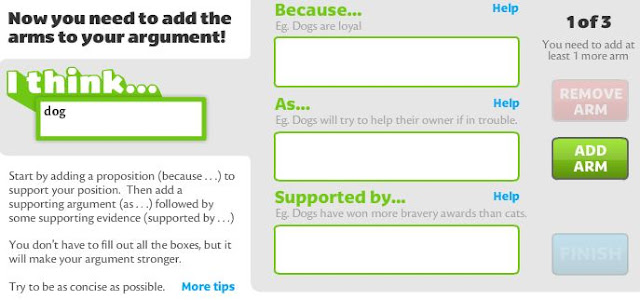If I used this in a classroom, I would start with a quick lesson on how to fill out the aMap form:
- Your position (I think . . .) – what you think overall
- Propositions (Because . . .) – reasons that support your position
- Arguments (As . . .) – supporting arguments that back up each of your propositions
- Evidence (Supported by . . .) – supporting evidence to back up your arguments
It looks like this:

Their example is:
I THINK... "Man U are the best team in the Premiership” (State their position)
BECAUSE... "They’re the most successful on the pitch” (State their proposition/reason)
AS... "They win the most silverware and have the best players” (State supporting argument)
SUPPORTED BY...“In 2008 Man U won the Champions League and Ronaldo won best European Player of the year.” (State supporting evidence)
aMap even offers a powerpoint for teachers:
View more presentations from Delib
Students can also look over examples of already created aMaps.
I would require students to create a minimum of one map and to reply to a minimum of 3 of their classmates' maps. Students would choose their issue in class on a sign-up sheet to ensure that multiple people do not choose the same topic. They would also draft their map either in class or as a homework assignment because it is difficult to edit in the website.
Pros/Cons
+integrates technology into teaching students how to debate
+lays out a basic format for creating an argument
+their maps can be expanded upon for a formal paper later on
+can follow maps on twitter, facebook, and myspace
-no way to edit your aMap once you've officially shared it so students would have to create and edit their arguments on paper or in a Word document first
-its format is rigid and not very flexible- some arguments and points are more complicated than the 3 tiered argument they offer and others may be simpler.
-text for each box is limited by a set number of characters
This lesson fulfills the following GLCE's for 8th Grade Language Arts
W.PR.08.03 draft focused ideas experimenting with various ways of sequencing information including ordering arguments, or sequencing ideas chronologically by importance when writing compositions.
S.DS.08.01 engage in interactive, extended discourse to socially construct meaning in book clubs, literature circles, partnerships, or other conversation protocols.
S.DS.08.02 respond to multiple text types in order to explore problems and pose solutions supported with evidence, take a stand on an issue and support it, and identify personally with a universal theme.
METS
6-8.CI.3. illustrate a content-related concept using a model, simulation, or concept-mapping software
6-8.CC.1. use digital resources (e.g., discussion groups, blogs, podcasts, videoconferences, Moodle, Blackboard) to collaborate with peers, experts, and other audiences
I used 8th grade GLCE's, but I think this site could be used in any classroom from late elementary through even high school depending on how it's used and the need of the students.
I am still not confident with the form they use especially the "supporting argument: As....." It's one of those situations in which I get it when I look at their examples but I am unsure what to put when creating my own.
My example:

Love, love, love this tool! I have never used it but I cannot wait to try it out. In one of my classes right now, we are learning how to teach students to make arguments and back them up with warrants and this would be the perfect tool to get them started! Thank you for posting this! I even sent the link to my prof so she could share it with the class.
ReplyDeleteThank you for sharing this. I used to find debates uncomfortable when I was younger. However, I feel that they are important to learn. It is important for students to learn how to back themselves up and reason. If we had this tool back when I was in grade school I feel that I would be more comfortable debating with my peers and sharing my opinions. I think this tool will be great for students who may not normally feel comfortable. Do you think there could be some negatives to using this rather than having the student debate vocally?
ReplyDeleteOh, I didn't think about students who would feel uncomfortable debating- that's a good point.
ReplyDeleteYeah, I DO think that there are disadvantages. My main disappointments with aMap are expressed briefly in the Pros/Cons section of the post. I see this tool as a good way to show students that they need a statement/opinion, a reason, and evidence or facts. I see it as a starting place.
Perhaps for students uncomfortable with debating, this could provide enough structure and preparation for them to feel comfortable with a verbal debate...? Although, I do definitely see the advantage of written discussion because it allows for critical thinking, research, and editing. Maybe there is a better tool out there that would allow for more free style debating. Perhaps blogging could be used for the same function as the aMap. The main advantage I see for verbal debates is the intonation and nonverbal cues communicated which are lost in written text as well as it gives an upper hand to students who excel at thinking on their feet.